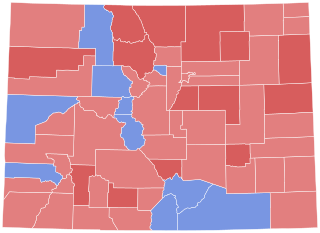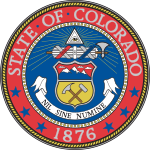
Alva Blanchard Adams was a Democratic politician who represented Colorado in the United States Senate from 1923 until 1924 and again from 1933 to 1941.

Ralph Lawrence Carr was an American attorney and politician who served as the 29th Governor of Colorado from 1939 to 1943.

Teller Ammons was an American attorney and politician who served as the 28th Governor of Colorado from 1937 to 1939. He was the first Colorado governor to be born in the state.

The 1938 United States Senate election in Colorado took place on November 8, 1938. Incumbent Democratic Senator Alva B. Adams ran for re-election to a second term. Adams faced Denver attorney Archibald A. Lee, the Republican nominee, in the general election. Despite the nationwide Republican landslide, including Republicans' landslide victory in the gubernatorial election that year, Adams's popularity translated into an easy re-election campaign. Adams ended up defeating Lee with 58% of the vote. However, Adams did not end up fully serving his second term; he died on December 1, 1941.

The 1942 United States Senate election in Colorado took place on November 3, 1942. Incumbent Democratic Senator Edwin C. Johnson was re-elected to second term over Republican Governor Ralph L. Carr.

The 1936 United States Senate election in Colorado took place on November 3, 1936. Incumbent Democratic Senator Edward P. Costigan did not seek a second term in office. Democratic Governor Ed Johnson won the open race to succeed him over Raymond L. Sauter.

The 1950 United States Senate election in Colorado took place on November 7, 1950. Incumbent Republican Senator Eugene Millikin ran for re-election to his second full term. He faced a strong challenge from Congressman John A. Carroll, the Democratic nominee, in the general election. Carroll ultimately lost, but despite facing considerable headwinds nationwide, held Millikin to the narrowest victory of his career.

The 1944 United States Senate special election in Colorado took place on November 7, 1944. Incumbent Republican Senator Eugene Millikin, who was first appointed to fill Alva B. Adams's seat in 1941 and re-elected at the ensuing special election in 1942, ran for re-election to his first full term. In the general election, he faced wealthy Denver attorney Barney L. Whatley. Millikin benefited from the strong Republican performance in Colorado—Thomas E. Dewey and Governor John C. Vivian both won their respective elections by decisive margins—and cruised to a landslide victory over Whatley.

The 1942 United States Senate special election in Colorado took place on November 3, 1942. Democratic Senator Alva B. Adams died in office on December 1, 1941, and Republican Governor Ralph L. Carr appointed Denver oilman Eugene Millikin to fill the vacancy. Millikin ran for re-election for the remainder of Adams's term. He was opposed in the general election by James A. Marsh, the former chairman of the state Democratic Party. Aided in part by the nationwide Republican landslide, Millikin easily defeated Marsh to serve out the remainder of the term.

The 2018 United States House of Representatives elections in Colorado were held on November 6, 2018, to elect the seven U.S. representatives from the state of Colorado, one from each of the state's seven congressional districts. The Republican and Democratic Party primaries in Colorado were held on June 26, 2018. The elections coincided with the gubernatorial election, as well as other elections to the House of Representatives, elections to the United States Senate, and various state and local elections.

The 1914 United States Senate election in Colorado took place on November 3, 1914. It was the first direct U.S. Senate election in Colorado following the ratification of the Seventeenth Amendment. Incumbent U.S. Senator Charles S. Thomas, a Democrat, who was first elected by the state legislature to fill a vacancy in 1913, ran for re-election to a full term.

The 1920 United States Senate election in Colorado took place on November 2, 1920. Incumbent Democratic Senator Charles S. Thomas initially declined to run for re-election, and State Supreme Court Justice Tully Scott won the Democratic nomination to succeed him, facing off against former Leadville Mayor Samuel D. Nicholson, the Republican nominee. However, in October 1920, Thomas announced that he would run for re-election as the nominee of the National Party. However, Thomas's decision did not ultimately affect the outcome of the election. Aided by Republican presidential nominee Warren G. Harding's strong performance in the state, as well as Republican Governor Oliver Henry Shoup's landslide re-election, Nicholson defeated Tully and Thomas in a landslide. Out of four candidates, Thomas placed fourth, winning just 3% of the vote and finishing behind Farmer–Labor nominee G. F. Stevens.

The 1924 United States Senate special election in Colorado took place on November 4, 1924, to fill the remainder of the term for which Samuel D. Nicholson was elected in 1920. Nicholson died in office on March 24, 1923, and Democratic Governor William Ellery Sweet appointed Alva B. Adams, a prominent Pueblo attorney, to fill the vacancy. Adams, however, declined to be a candidate in the special election, instead challenging incumbent Republican Senator Lawrence C. Phipps in the regular election the same year.

The 1926 United States Senate election in Colorado took place on November 2, 1924. Incumbent Republican Senator Rice W. Means ran for re-election, but he was defeated in the Republican primary by Charles W. Waterman, a prominent attorney and party leader. In the general election, Waterman faced former Governor William Ellery Sweet, the Democratic nominee. Despite the nationwide Democratic trend, as well as the landslide victory for Democrats in the gubernatorial election, Waterman ended up defeating Sweet by a thin margin. Waterman would not end up serving a full term in the Senate, and died in office on August 27, 1932.

The 1930 United States Senate election in Colorado took place on November 4, 1930. Republican Senator Lawrence C. Phipps declined to run for re-election, resulting in an open race to replace him. Edward P. Costigan, one of the founding members of the Progressive Party in Colorado and a former member of the United States Tariff Commission, won the Democratic nomination and faced attorney George H. Shaw, the Republican nominee, in the general election. Aided by the nationwide Democratic landslide, Costigan handily defeated Shaw, becoming the first Democrat elected to the Senate from Colorado since 1914.

The 1912 Colorado gubernatorial election took place on November 8, 1912. Democratic state Senator Elias M. Ammons defeated the Progressive, Republican and Socialist candidates future Senator Edward P. Costigan, Clifford C. Parks and Charles A. Ashelstrom with 42.91% of the vote.

The 1940 Colorado gubernatorial election was held on November 5, 1940. Incumbent Republican Ralph Lawrence Carr defeated Democratic nominee George E. Saunders with 54.37% of the vote.

The 1936 Colorado gubernatorial election was held on November 3, 1936. Democratic nominee Teller Ammons defeated Republican nominee Charles M. Armstrong with 54.57% of the vote.

The 2022 Colorado gubernatorial election was held on November 8, 2022. Incumbent Democratic Governor Jared Polis won re-election to a second term, defeating Republican University of Colorado regent Heidi Ganahl. The primary election was held on June 28.

The 1932 United States Senate elections in Colorado took place on November 8, 1932. Incumbent Republican Senator Charles W. Waterman announced that he would not seek re-election to a second term. Attorney Karl C. Schuyler won the Republican nomination to succeed Waterman and faced former Senator Alva B. Adams, the Democratic nominee, in the general election.
















